The Wreck of the Minnehaha
Next | Previous | Return to Start
|
In the surf of Lake Michigan at the south end of Camp Arcadia are the remains of the hull of the Minnehaha, one of the largest sailing ships on the Great Lakes. |
|
|
|
|
|
The Minnehaha was a 4-masted, 200 foot, wooden schooner carrying 823 gross tons and 782 net tons. Based primarily in Lake Erie near Buffalo and then Cleveland, the ship was used to haul cargo in Lakes Erie, Huron, and Michigan. “She was built in 1880 [by Linn & Craig in Gibralter, Michigan] and has been unfortunate from the start. Two years ago [in 1891] she was wrecked near Detour [at the north end of Lake Huron], and remained on the rocks all winter, being abandoned to the underwriters, who finally rescued the wreck and sold it.” --Buffalo Evening News Monday, October 16, 1893 In October of 1893, the steam barge Henry J. Johnson was towing the Minnehaha from Chicago bound for Point Edward at the south end of Lake Huron with 58,000 bushels of corn. At 7:30 PM on October 13, the two ships found themselves off Point Betsie facing 90 mile per hour gale force winds. They tried to find shelter behind the Manitou Islands, but at dawn the next day, they were still south of Sleeping Bear Point fighting high winds and waves to stay out of shallow water. Captain Benniteau of the Johnson decided to turn the ships south and head to Frankfort, the nearest refuge. However, somewhere near Frankfort high waves crashed over the Minnehaha's deck, smashed two hatch covers, and began filling the hold with water. William Parker, captain of the Minnehaha, realizing his ship was in serious trouble, sent up distress signals, released the tow lines, and headed for the beach. There was nothing the crew of the Johnson could do but avoid the same shallow water. The Minnehaha ran aground about a quarter of a mile offshore between Burnham and Arcadia. To avoid the waves sweeping the decks, all but one member of the crew, who drowned trying to swim to shore, climbed into the ship's rigging. As the ship was breaking up, the captain called to the crew to grab whatever would float and go over the side anyway. But only the captain made it to shore safely. One crew member made it to a pier, but was too tired to hold onto a pole used to try to pull him to safety. “The captain said that his hatches went over the rail and the hold began to fill with water when he cut loose; but a few minutes after he struck, the vessel broke in two and within half an hour nothing but the bow was left. The crew were amidships while he was at the stern when the vessel broke. He took a plank and jumped. They had no life preservers on board, and the opinion of the captain was that, if there had been, all would be alive today.” --Buffalo Evening News October 16, 1893 People on shore rode by horseback to Frankfort's lifesaving station and to Onekama to phone Manistee's lifesaving station. The Frankfort crew arrived at 5PM, but repeated attempts to reach the vessel by surfboat failed. By the time they fired two shot lines over the bow, which was all that was visible by then, and reached the Minnehaha, there were no signs of life. Because their path was obstructed by trees blown down by the storm, the Manistee lifesaving crew reached the site at midnight in time to work with the Frankfort crew the rest of the night looking for survivors. Lives lost:
|
Gross and Net Tons. In nautical terms a ton is 100 cubic feet used to describe a ship's capacity. Net tons describe the amount of space in the hold and between decks, and gross tons include that and the space on the deck, anywhere cargo could be stuffed. |
|
By morning the beach was covered with timbers and wreckage, all that was left of the huge sailing ship. On the evening of the next day the body of the ship's cook was discovered on the beach nineteen miles south (or two miles north, depending on the source). The cargo of corn washed ashore for several days. Today all that's left is wreckage that appears to be the starboard (right) side of the hull near the bow shown in the picture foreground. This piece is about 169 ft. long by 14.5 ft wide at the widest point. Note the layers of outer hull (bottom layer), ribs, and inner hull. The hull's ribs in the foreground arch much more than those in the background.
|
|




